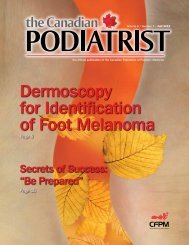Disinfection and Sterilization in the Chiropody Office
Disinfection and Sterilization in the Chiropody Office
Disinfection and Sterilization in the Chiropody Office
Create successful ePaper yourself
Turn your PDF publications into a flip-book with our unique Google optimized e-Paper software.
3<br />
Change solution frequently – daily. R<strong>in</strong>se <strong>the</strong> <strong>in</strong>struments with water after ultrasonic clean<strong>in</strong>g to<br />
remove solution.<br />
3. After Clean<strong>in</strong>g<br />
Any <strong>in</strong>struments with h<strong>in</strong>ges/screws/movable parts should be selected <strong>and</strong> placed <strong>in</strong> an<br />
Instrument Lubricant Milk Bath (usually for 5 m<strong>in</strong>utes), <strong>and</strong> <strong>the</strong>n r<strong>in</strong>sed <strong>in</strong> warm water.<br />
4. Before Autoclav<strong>in</strong>g<br />
1. Inspect <strong>in</strong>struments for any blood or debris.<br />
2. Make sure <strong>in</strong>struments are completely dry.<br />
3. Use <strong>the</strong> appropriate steriliz<strong>in</strong>g pouch size for <strong>in</strong>struments<br />
4. Place <strong>in</strong>strument guards when needed to prevent punctur<strong>in</strong>g pouches<br />
5. Seal Pouch.<br />
6. For grouped surgical sets <strong>in</strong>sert a sterile <strong>in</strong>dicator strip. Place autoclave tape on<br />
outside of <strong>the</strong> wrapped <strong>in</strong>strument tray.<br />
7. Transfer trays to central steriliz<strong>in</strong>g services.<br />
5. Autoclav<strong>in</strong>g<br />
Individual Instruments:<br />
Disposable pouches are ideal. Make sure you use a wide enough pouch for <strong>in</strong>struments with<br />
ratchet locks such as nippers <strong>and</strong> hemostats so <strong>the</strong> <strong>in</strong>strument can be sterilized <strong>in</strong> an open<br />
(unlocked) position.<br />
Instrument Sets:<br />
Unlock all <strong>in</strong>struments <strong>and</strong> sterilize <strong>the</strong>n <strong>in</strong> an open position. Place heavy <strong>in</strong>struments on<br />
bottom of set (when 2 layers are required). Place <strong>in</strong> a sterilizable tray <strong>and</strong> wrap entire tray with<br />
sterilization wrap<br />
Rationale<br />
Never lock an <strong>in</strong>strument dur<strong>in</strong>g autoclav<strong>in</strong>g. It will not be sterile as steam cannot reach <strong>the</strong><br />
metal to metal surfaces. The <strong>in</strong>strument will develop cracks <strong>in</strong> h<strong>in</strong>ge areas because of heat<br />
expansion dur<strong>in</strong>g <strong>the</strong> autoclave cycle.<br />
Sample Performance Indictors & Record Keep<strong>in</strong>g<br />
Please feel free to pr<strong>in</strong>t any of <strong>the</strong> below <strong>in</strong>formation <strong>and</strong> customize <strong>the</strong> details for your office<br />
<strong>and</strong> your br<strong>and</strong> of sterilizer. The below is a sample from a chiropody cl<strong>in</strong>ic to illustrate <strong>the</strong><br />
details required. You should also review from The College of Chiropodist Of Ontario’s website,<br />
under <strong>the</strong> head<strong>in</strong>g Infection Control gives <strong>the</strong> details of <strong>the</strong> m<strong>in</strong>imal requirements.<br />
COCOO St<strong>and</strong>ards of Infection Control<br />
1. Member shall endeavor to prevent <strong>the</strong> transmission of microorganisms from<br />
patient to patient, patient to member <strong>and</strong> member to patient.
















